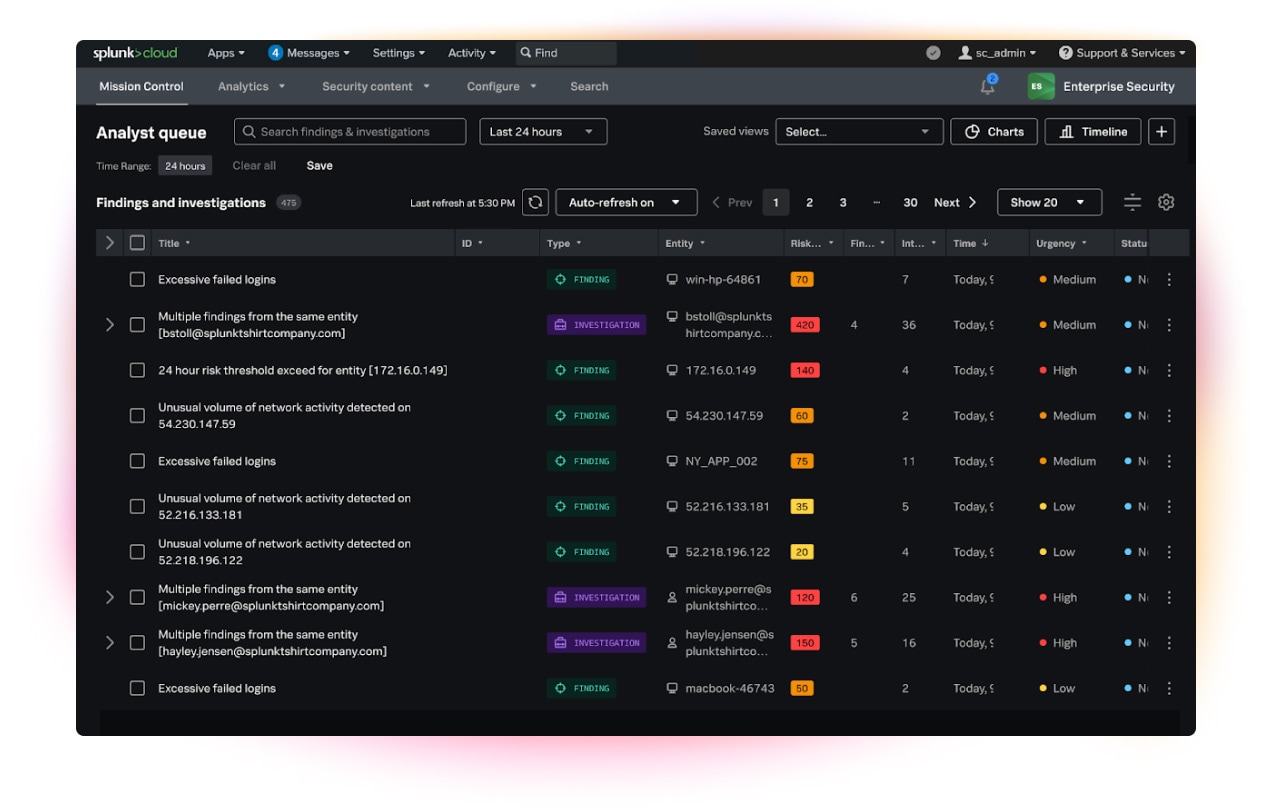Market-leading SIEM to quickly detect, investigate, and respond to threats.
15 Must-Have SIEM Features for Modern Threat Defense in 2026
Key takeaways
- Modern SIEM platforms are strategic security hubs that unify data from across hybrid infrastructures, detect threats in real time, and enable automated response to reduce attack impact.
- These 15 must-have features, including UEBA, SOAR integration, risk-based alerting, and advanced analytics, are critical for keeping pace with evolving cyberattacks in 2025 and beyond.
- Feature prioritization should match your environment. Small teams should focus on automation and alert management, while enterprises need scalability, compliance automation, and tailored detection rules.
In 2025, the Security Information and Event Management (SIEM) platform has evolved into far more than a log collector. It is now the central nervous system of a security operations center (SOC), offering a variety of use cases like:
- Integrating data from across an organization’s infrastructure.
- Correlating threats in real time.
- Triggering automated responses to contain attacks before they spread.
- And much more.
But not all SIEMs are created equal. To counter today’s advanced threats, from state-sponsored campaigns to ransomware-as-a-service, your SIEM needs a specific set of must-have capabilities. As Gartner notes in its latest Magic Quadrant for SIEM, “Security and risk management leaders should consider SIEM solutions that deliver advanced analytics, cloud-native scalability, and native SOAR capabilities to keep pace with modern threats.”
This guide organizes the 15 essential features of a modern SIEM into functional categories, so you can quickly see which matter most for your environment.
Quick reference: Modern SIEM must-have features
Feature |
Core purpose |
Primary benefit |
Log collection & normalization |
Centralizes and standardizes logs |
Faster, unified analysis |
Real-time event orrelation |
Connects attack steps in real time |
Stops multi-stage attacks early |
Centralized dashboard & reporting |
Single-pane visibility & reports |
Better decision-making |
Threat intelligence integration |
Enriches data with global IOCs |
Detects known malicious activity |
UEBA |
Learns & flags abnormal behavior |
Catches insider/unknown threats |
SOAR integration |
Automates playbooks |
Cuts response time |
Alert prioritization & risk scoring |
Ranks threats by impact |
Reduces alert fatigue |
Compliance management |
Streamlines audits |
Maintains regulatory readiness |
Scalability & performance |
Handles growing log volumes |
Keeps performance steady |
Custom rule development |
Tailors detections |
Finds targeted threats |
Adds asset/user context |
Prioritizes critical alerts |
|
Historical search & forensics |
Investigates past events |
Builds timelines, finds root cause |
Cloud & hybrid support |
Monitors multi-environment infra |
Eliminates blind spots |
Multi-tenancy & RBAC |
Controls data access |
Improves governance |
Advanced Analytics & ML |
Detects unknown threats |
Reduces false positives |
Now let’s take a detailed look at each of these. We’ve organized the 15 features into categories for easier sorting:
- Data collection and visibility
- Real-time threat detection
- Response and automation
- Compliance and governance
- Scalability and adaptability
- Context and investigation
Let’s get started.

Splunk is an Industry Leader in SIEM
Category: Data collection and visibility
These features make sure your SIEM sees everything and presents it in a way security analysts can understand, no matter the source.
1. Log collection and normalization: The foundation of SIEM
A SIEM’s power starts with its ability to ingest logs from diverse sources and standardize them into a uniform format. SIEM platforms collect and standardize logs from various sources: firewalls, antivirus and endpoint protection, cloud services, IoT devices, servers and operating systems, and more.
SIEMs collect and normalize log data through various methods (such as agents, APIs, and syslog servers), enabling a centralized view of all logs from different systems and devices. The consistent format can now be easily correlated with other information, making it easier to detect threats and reduce unnecessary noise.
Why this matters: Logs from various systems and vendors have different structures, making correlation slow and error-prone. SIEMs solve this by converting logs into a uniform format, known as normalization.
Example: With hybrid workforces and multiple SaaS tools, log normalization ensures you can correlate a login attempt in Azure AD with suspicious file activity in Google Drive — even though the raw log formats are different.
2. Centralized dashboard and reporting: One source of truth
Modern SIEMs provide both:
- Real-time, centralized dashboards for SOC analysts that helps track alerts and visualize threat trends and KPIs.
- Tailored, role-based reports for executives, CISOs, and auditors that support compliance, audit preparation, and organizational decision-making.
Why this matters: Centralization improves situational awareness and visibility and supports compliance, all without switching between multiple tools.
Example: A SOC manager can see a live heatmap of attack activity while a compliance officer pulls an automated PCI DSS report from the same system.
Category: Real-time threat detection
These capabilities spot and contextualize threats as they happen, enabling fast containment.
3. Real-time event correlation: Detecting the full attack chain
Most cyberattacks involve multiple steps or events. Correlating these events in real time, using correlation rules and behavior models, SIEM platforms can track sequences that can indicate:
- Phishing or spear phishing
- Credential use
- Privilege escalation
- Data exfiltration
These correlations go beyond simple pattern matching, often relying on temporal proximity, user or asset identities, and behavioral baselines to infer threats for earlier response.
Why this matters: Because cyberattacks often unfold in stages, the ability to detect blended or multi-stage attacks in real time means you can act before the attack escalates.
Example: A modern SIEM can detect that a login from a new country was followed by privilege escalation and then an API download request. This pattern, or correlation, triggers an immediate alert and initiated an automated block.
4. Threat intelligence integration: Bringing global context
SIEMs enrich internal log data by integrating external threat intelligence feeds to detect malicious behavior, IPs, domains, hashes, CVEs, and more.
Why this matters: Instead of relying solely on internal detections, SIEMs leverage a global knowledge base of active threats. This external context enhances alert accuracy, prioritizes known threats, and supports more efficient and targeted responses."
Example: A login attempt from an IP flagged by CISA’s latest advisory is instantly quarantined.
5. User & entity behavior analytics (UEBA): Finding the anomalies
Leading SIEMs introduce UEBA, the use of machine learning to establish normal behavior patterns for users and systems (entities), and flag deviations and unknown patterns that may indicate malicious activity or require more protection.
UEBA helps detect threats that don't match known attack signatures, like insider threats, stolen credentials, and suspicious data transfers. Unlike static rules or signature-based tools that rely on pre-defined knowledge, UEBA adapts and evolves with user behavior (login times, locations, resources accessed, data consumed), greatly improving detection of subtle anomalies.
Why this matters: When combined with real-time correlation, UEBA adds a critical behavioral dimension to threat detection.
Example: A contractor downloading 20GB of sensitive files outside normal work hours triggers an anomaly alert.
Watch this video for a 30-second overview of SIEM platforms. Learn more in our full guide to SIEM.
Category: Response and automation
Once a threat is detected, these features ensure you respond before damage is done.
6. Incident response automation (SOAR Integration)
SIEM-SOAR integration reduces operational bottlenecks. SIEMs can execute automated responses (pre-built and custom) via integrated SOAR platforms, such as:
- Isolating endpoints.
- Revoking credentials.
- Notifying teams and stakeholders.
Why this matters: Manual response is slow and error-prone. SIEM/SOAR-integrated automation reduces mean time to repair (MTTR), executes playbooks consistently, and reduces analyst workload.
Example: When ransomware behavior is detected, the SIEM triggers a SOAR workflow that disconnects the infected host from the network within seconds.
7. Alert prioritization and risk scoring: Focus on what matters
SIEMs rank alerts based on asset value, threat severity and context, business impact, threat intel matches, and past history. Risk-based alerting (RBA) gives security teams the ability to pivot resources from traditionally reactive functions to proactive functions in the SOC.
Additionally, advanced SIEMs apply dynamic risk scoring models that learn over time. Some systems allow tuning thresholds or integrating business-specific context, such as tagging VIP users or critical infrastructure. This helps organizations focus limited resources on the most urgent threats.
Why this matters: True positive rate increases, allowing more resources to be shifted to higher impact tasks like threat hunting or adversary simulation.
Example: An alert involving a domain admin on a production database gets a higher score than one on a test server.
Category: Compliance and governance
Security isn’t just about stopping attacks. You also need to prove you’ve done it.
8. Compliance management: Audit readiness at scale
SIEMs provide tools and templates to meet regulatory requirements (such as PCI DSS, HIPAA, and ISO 27001), enabling smoother and easier compliance reporting. Regulatory compliance may be required for legal, financial, and/or reputational reasons.
Why this matters: SIEMs make compliance management easier, retaining logs, monitoring access, and automating reports. Built-in policy packs often include pre-configured rules, dashboards, and reports tailored to each framework. These reduce the burden of manual compliance checks and enable continuous assurance rather than reactive audits.
Example: Automatically generating GDPR data access logs during an audit request.
9. Multi-tenancy & role-based access control (RBAC)
With this feature, SIEMs enforce fine-grained access control and support secure, multi-tenant architectures. Large companies or MSSPs require:
- Separation of data across business units
- Custom views and access per user role
- Governance for data access
RBAC ensures users can access only what they need, reducing risk and supporting internal security policies. Multi-tenancy supports isolation of data, rules, and dashboards for different teams or customers.
Why this matters: Combined with audit logging, multi-tenancy and RBAC support both security and operational integrity.
Example: An MSSP serving multiple banks keeps each bank’s data isolated while allowing analysts access only to their assigned tenant.
Category: Scalability and adaptability
As data volumes grow, your SIEM must keep pace without performance dips.
10. Scalability and performance optimization
As data volumes increase, modern SIEMs are designed to grow with the organization, adapting to higher volumes while maintaining speed and reliability. This feature supports horizontal scaling, cloud ingestion, and tiered storage to handle large, growing data volumes.
Some platforms offer tiered storage, separating hot (frequent access) and cold (archival) data. This saves cost and optimizes performance for active investigations while still retaining historical data.
Why this matters: Maintains speed and reliability for real-time searches even as data grows.
Example: A retail chain doubling its stores still processes all logs without latency.
11. Support for cloud & hybrid environments: No blind spots
SIEMs today must monitor hybrid infrastructure across on-premises systems, hybrid clouds, and Kubernetes/containerized environments. Modern SIEMs offer auto-discovery and API connectors for major cloud services, enabling real-time visibility into ephemeral workloads and distributed architectures. This ensures consistent security across all operational layers.
Why this matters: Ensures visibility across all environment and infrastructure layers, so you have maximum context and zero blind spots.
Example: Monitoring AWS CloudTrail, Kubernetes, and legacy Windows servers in a single SIEM view.
12. Customizable rules and use cases
Modern SIEMs must allow security teams to create and deploy rules tailored to their environment. Why? Generic rules cannot catch many threats, but customized rules can detect policy violations, support internal controls, and track business-specific risks.
This customization — via rule, scripting, and visual builders — allows SOC teams to align detection capabilities with their evolving threat models. Documentation and comment fields also support rule governance and knowledge transfer between team members.
Why this matters: Customizing your SIEM means finding threats that are unique to your industry and your business.
Example: A global logistics firm might create a custom rule to flag any direct database query from an unapproved IP address to its proprietary route optimization system, a critical business asset that generic network rules might overlook.
Category: Context and investigation
These SIEM features turn raw data into actionable intelligence and uncover what happened.
13. Data enrichment and contextualization: More context from logs
Beyond purely cybersecurity use cases, SIEMs can enhance logs with additional context to make alerts more meaningful. This brings in more context from isolated logs throughout your organization, giving more context to your data and bridging the gap between technical events and business risk.
Modern SIEMs can enrich logs from sources like asset databases, geolocation data, Active Directory, vulnerability scans, and much more to answers key questions like:
- Who initiated the action?
- Where did it happen?
- What is the asset's criticality?
Why this matters: Contextual information turns basic log entries into actionable insights.
Example: Knowing that an alert involves a domain admin account on a high-value database server justifies a faster response.
14. Historical search and forensics
Not all threats are immediate — and that’s why historical data search is a key feature of SIEMs. SIEM platforms support long-term storage and complex search capabilities that help to:
- Reconstruct attack timelines.
- Identify "patient zero".
- Support legal and compliance inquiries.
Historical data is also useful for proactive threat hunting, allowing analysts to search for indicators of compromise (IOCs) that were unknown at the time. This helps detect dormant threats or validate the scope of past incidents.
Why this matters: Historical search means you can reconstruct past incidents and detect dormant threats.
Example: Tracing the first appearance of an undetected backdoor that, turns out, was installed months earlier.
15. Advanced analytics & machine learning
Because some attacks don’t match known patterns, modern SIEMs leverage AI and machine learning to detect unknown or complex threats through anomaly detection or clustering based on suspicious user behavior.
Advanced analytics also supports alert deduplication, threat scoring enhancements, and auto-baselining of normal behavior. These capabilities help reduce false positives while identifying emerging threats and complement rule-based systems by offering insights that are difficult to define with static logic alone.
Why this matters: Extends detection beyond static rules.
Example: Identifying subtle privilege escalation patterns that traditional rule sets would miss.
Learn more about this topic in our guide to AI Use Cases for the SOC.
How to prioritize SIEM features today
- Small security teams: Focus on automation (SOAR), alert prioritization, and UEBA for maximum impact with limited staff.
- Large enterprises: Prioritize scalability, compliance automation, and custom rule creation to handle complex operations.
- Cloud-native organizations: Ensure deep cloud/hybrid support, threat intelligence integration, and AI-based analytics.
Final takeaways
A modern SIEM should be more than a tool. Today’s SIEMs are strategic security platforms that evolves with your threats, your infrastructure, and your business. By selecting a solution that delivers on these 15 must-have features, you build a foundation for faster detection, smarter response, and sustained compliance in the face of evolving cyber risk.
FAQs about SIEM Features
The 15 key features include log collection & normalization, real-time event correlation, centralized dashboards, threat intelligence integration, UEBA, SOAR automation, alert prioritization, compliance management, scalability, custom rule creation, data enrichment, historical search, cloud/hybrid support, multi-tenancy, and advanced analytics with machine learning.
UEBA detects abnormal behavior patterns that don’t match known attack signatures, helping identify insider threats, stolen credentials, and subtle attacks that traditional rules might miss.
SOAR automation reduces response time by executing predefined playbooks, such as isolating compromised endpoints or resetting credentials, directly from SIEM alerts.
Cloud & hybrid support, real-time event correlation, and threat intelligence integration are crucial for securing workloads across AWS, Azure, GCP, and container environments.
Large enterprises should focus on scalability, compliance automation, custom rule development, and multi-tenancy features to support complex, distributed environments while maintaining governance and performance.
Related Articles
About Splunk
The world’s leading organizations rely on Splunk, a Cisco company, to continuously strengthen digital resilience with our unified security and observability platform, powered by industry-leading AI.
Our customers trust Splunk’s award-winning security and observability solutions to secure and improve the reliability of their complex digital environments, at any scale.








